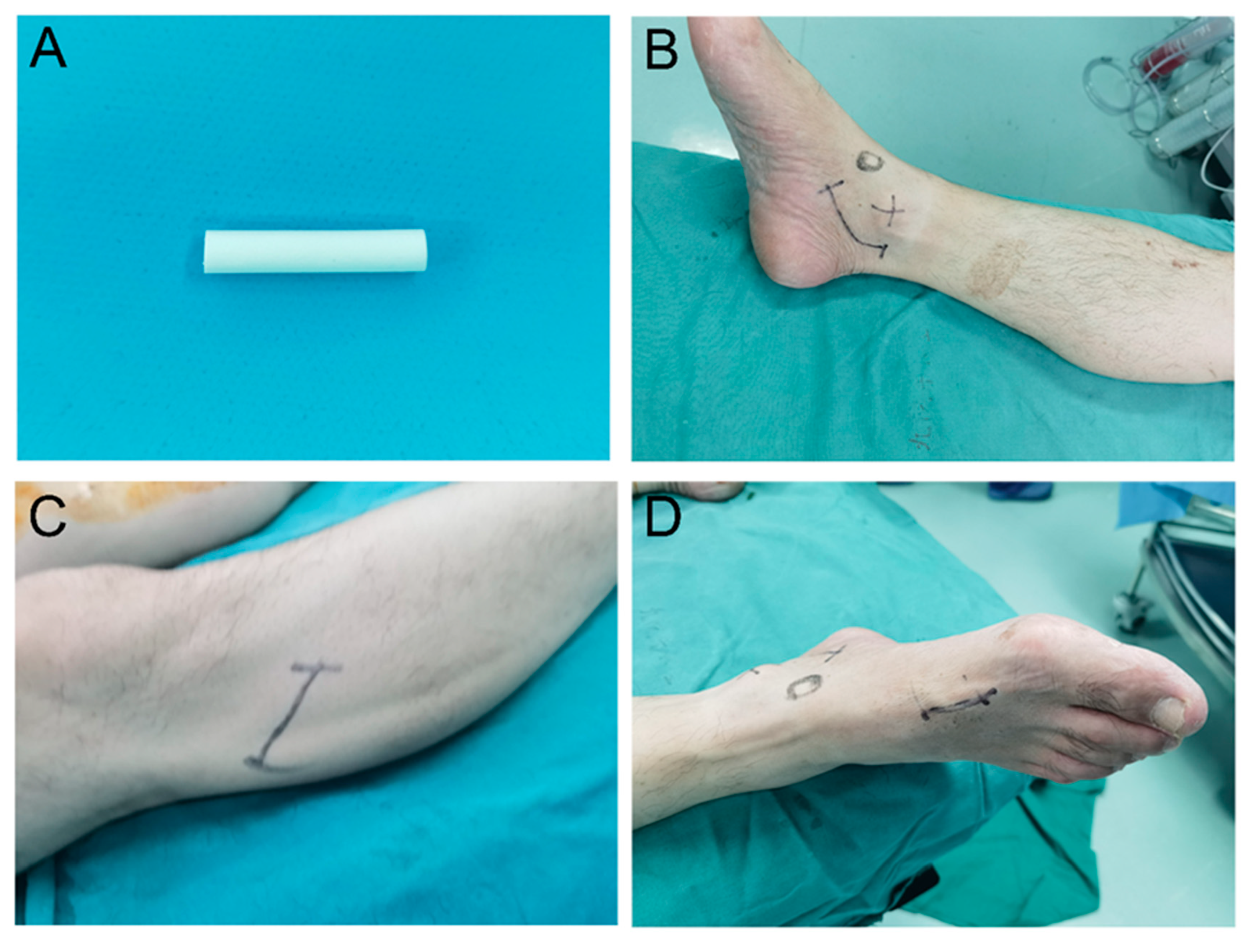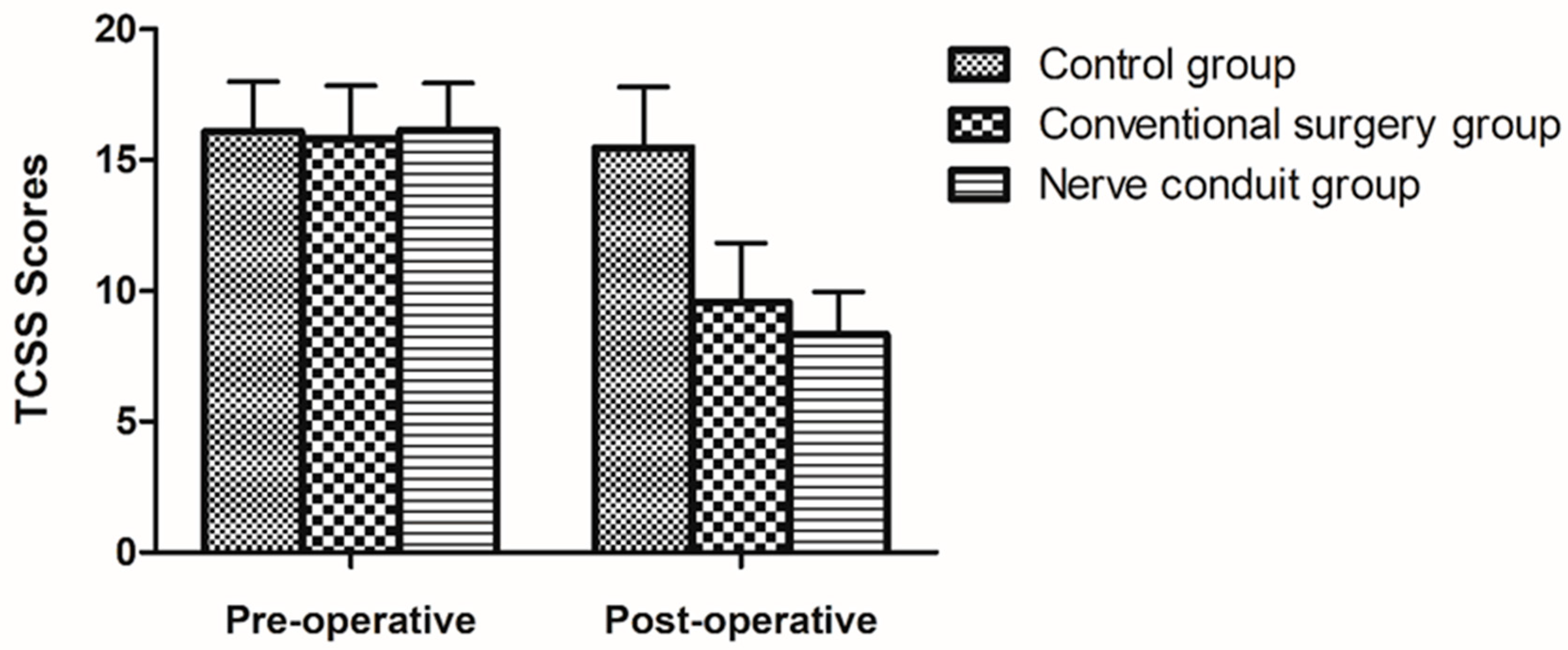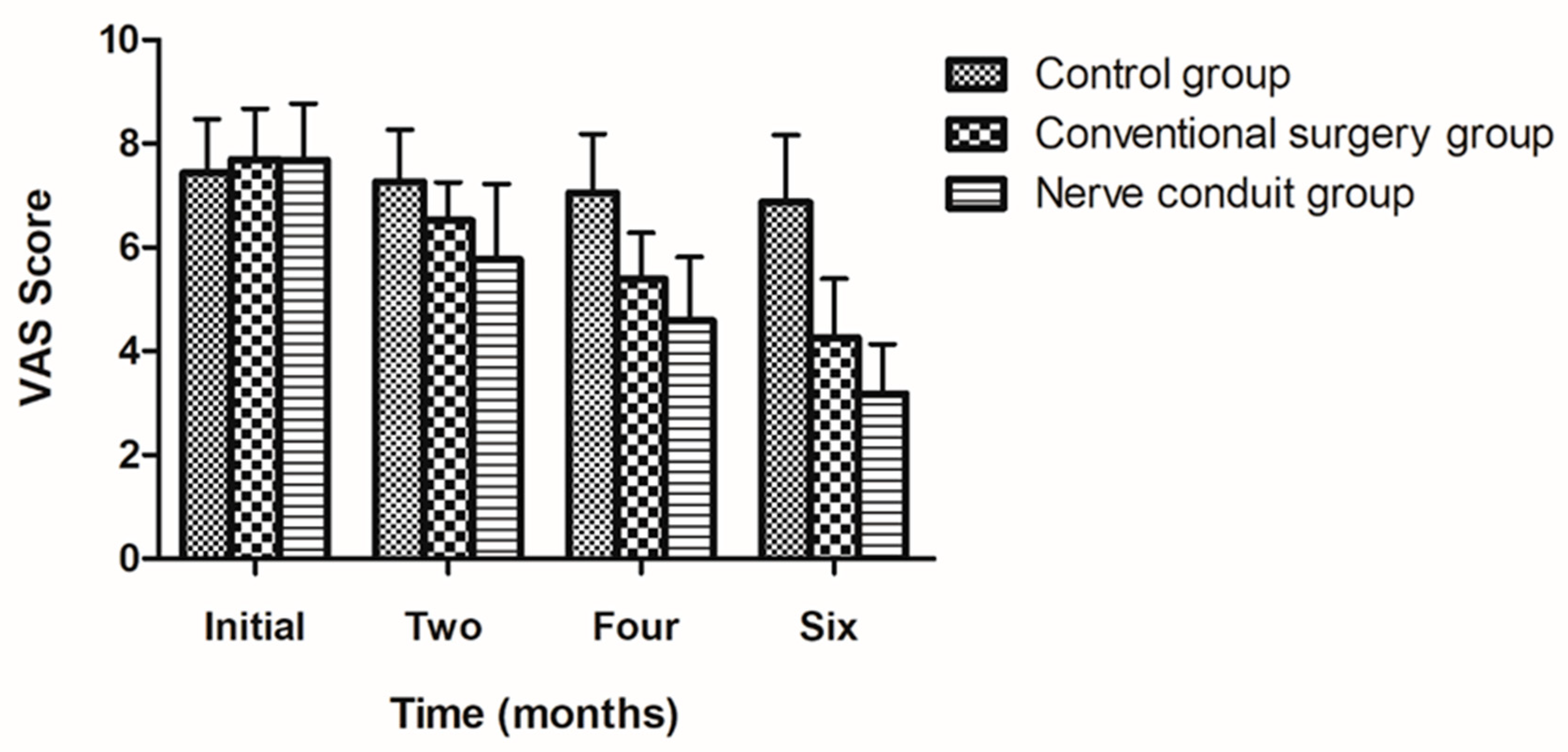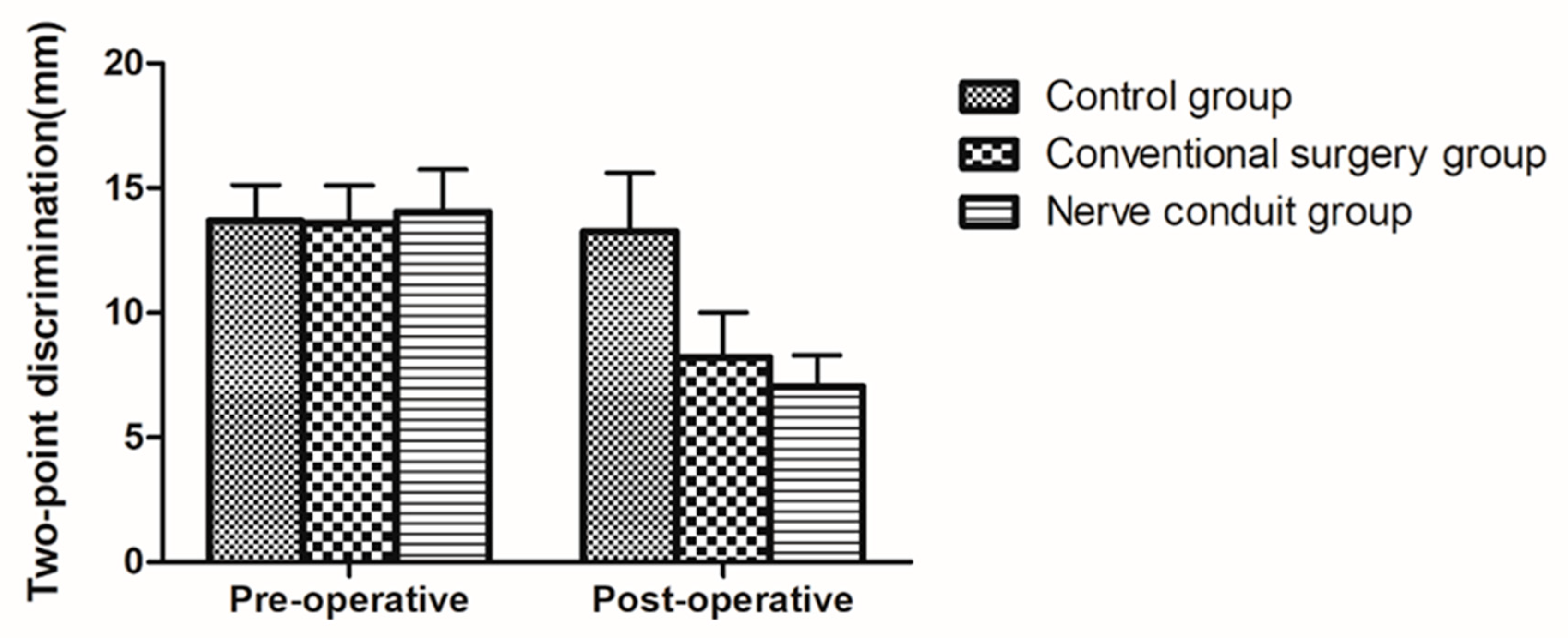Improving Effects of Peripheral Nerve Decompression Microsurgery of Lower Limbs in Patients with Diabetic Peripheral Neuropathy
Abstract
1. Introduction
2. Materials and Methods
2.1. General Data
2.2. Treatment Method
2.3. TCSS Score
2.4. VAS Score Measurement
2.5. Nerve Conduction Velocity (NCV)
2.6. 2-PD Test
2.7. Statistical Analysis
3. Results
3.1. General Data
3.2. TCSS Score
3.3. VAS Score
3.4. Electrophysiological Evaluation
3.5. 2-PD Test
4. Discussion
5. Conclusions
Author Contributions
Funding
Institutional Review Board Statement
Informed Consent Statement
Data Availability Statement
Acknowledgments
Conflicts of Interest
References
- Sangiorgio, L.; Iemmolo, R.; Le Moli, R.; Grasso, G.; Lunetta, M. Diabetic neuropathy: Prevalence, concordance between clinical and electrophysiological testing and impact of risk factors. Panminerva Med. 1997, 39, 1–5. [Google Scholar] [PubMed]
- Chitneni, A.; Rupp, A.; Ghorayeb, J. Early Detection of Diabetic Peripheral Neuropathy by fMRI: An Evidence-Based Review. Brain Sci. 2022, 12, 557. [Google Scholar] [CrossRef] [PubMed]
- Petit, W.A., Jr.; Upender, R.P. Medical evaluation and treatment of diabetic peripheral neuropathy. Clin. Podiatr. Med. Surg. 2003, 20, 671–688. [Google Scholar] [CrossRef]
- Boulton, A.J.; Vinik, A.I.; Arezzo, J.C.; Bril, V.; Feldman, E.L.; Freeman, R.; Malik, R.A.; Maser, R.E.; Sosenko, J.M.; Ziegler, D. Diabetic neuropathies: A statement by the American Diabetes Association. Diabetes Care 2005, 28, 956–962. [Google Scholar] [CrossRef]
- Ponirakis, G.; Elhadd, T.; Al Ozairi, E. Prevalence and risk factors for diabetic peripheral neuropathy, neuropathic pain and foot ulceration in the Arabian Gulf region. J. Diabetes Investig. 2022, 13, 1551–1559. [Google Scholar] [CrossRef] [PubMed]
- Siemionow, M.; Zielinski, M.; Sari, A. Comparison of clinical evaluation and neurosensory testing in the early diagnosis of superimposed entrapment neuropathy in diabetic patients. Ann. Plast. Surg. 2006, 57, 41–49. [Google Scholar] [CrossRef]
- Zhang, W.; Chen, L. A Nomogram for Predicting the Possibility of Peripheral Neuropathy in Patients with Type 2 Diabetes Mellitus. Brain Sci. 2022, 12, 1328. [Google Scholar] [CrossRef]
- Caffee, H.H. Treatment of diabetic neuropathy by decompression of the posterior tibial nerve. Plast. Reconstr. Surg. 2000, 106, 813–815. [Google Scholar] [CrossRef]
- Hagedorn, J.M.; Engle, A.M.; George, T.K.; Karri, J.; Abdullah, N.; Ovrom, E.; Bocanegra-Becerra, J.E.; D’Souza, R.S. An overview of painful diabetic peripheral neuropathy: Diagnosis and treatment advancements. Diabetes Res. Clin. Pract. 2022, 188, 109928. [Google Scholar] [CrossRef]
- Zhang, A.; Wang, Q.; Liu, M.; Tan, M.; Zhang, X.; Wu, R. Efficacy and safety of Mudan granules for painful diabetic peripheral neuropathy: A protocol for a double-blind randomized controlled trial. Medicine 2022, 101, e28896. [Google Scholar] [CrossRef]
- Putz, Z.; Tordai, D.; Hajdú, N.; Vági, O.E.; Kempler, M.; Békeffy, M.; Körei, A.E.; Istenes, I.; Horváth, V.; Stoian, A.P.; et al. Vitamin D in the Prevention and Treatment of Diabetic Neuropathy. Clin. Ther. 2022, 44, 813–823. [Google Scholar] [CrossRef] [PubMed]
- Ren, L.; Guo, R.; Fu, G.; Zhang, J.; Wang, Q. The efficacy and safety of massage adjuvant therapy in the treatment of diabetic peripheral neuropathy: A protocol for systematic review and meta-analysis of randomized controlled trials. Medicine 2022, 101, e29032. [Google Scholar] [CrossRef] [PubMed]
- Dellon, A.L. The Dellon approach to neurolysis in the neuropathy patient with chronic nerve compression. Handchir. Mikrochir. Plast. Chir. 2008, 40, 351–360. [Google Scholar] [CrossRef] [PubMed]
- Dellon, A.L. Treatment of symptomatic diabetic neuropathy by surgical decompression of multiple peripheral nerves. Plast. Reconstr. Surg. 1992, 89, 689–697, discussion 698–689. [Google Scholar] [CrossRef] [PubMed]
- Aszmann, O.C.; Kress, K.M.; Dellon, A.L. Results of decompression of peripheral nerves in diabetics: A prospective, blinded study. Plast. Reconstr. Surg. 2000, 106, 816–822. [Google Scholar] [CrossRef]
- Aszmann, O.; Tassler, P.L.; Dellon, A.L. Changing the natural history of diabetic neuropathy: Incidence of ulcer/amputation in the contralateral limb of patients with a unilateral nerve decompression procedure. Ann. Plast. Surg. 2004, 53, 517–522. [Google Scholar] [CrossRef]
- Wang, S.L.; Liu, X.L.; Kang, Z.C.; Wang, Y.S. Platelet-rich plasma promotes peripheral nerve regeneration after sciatic nerve injury. Neural Regen. Res. 2023, 18, 375–381. [Google Scholar] [CrossRef]
- Scott, J.; Huskisson, E.C. Graphic representation of pain. Pain 1976, 2, 175–184. [Google Scholar] [CrossRef]
- Onde, M.E.; Ozge, A.; Senol, M.G.; Togrol, E.; Ozdag, F.; Saracoglu, M.; Misirli, H. The sensitivity of clinical diagnostic methods in the diagnosis of diabetic neuropathy. J. Int. Med. Res. 2008, 36, 63–70. [Google Scholar] [CrossRef]
- Bril, V.; Perkins, B.A. Validation of the Toronto Clinical Scoring System for diabetic polyneuropathy. Diabetes Care 2002, 25, 2048–2052. [Google Scholar] [CrossRef]
- Malik, R.A. Novel mechanisms of pain in painful diabetic neuropathy. Nat. Rev. Endocrinol. 2022, 18, 459–460. [Google Scholar] [CrossRef] [PubMed]
- Trepman, E.; Nihal, A.; Pinzur, M.S. Current topics review: Charcot neuroarthropathy of the foot and ankle. Foot Ankle Int. 2005, 26, 46–63. [Google Scholar] [CrossRef]
- Daeschler, S.C.; Pennekamp, A.; Tsilingiris, D.; Bursacovschi, C.; Aman, M.; Eisa, A.; Boecker, A.; Klimitz, F.; Stolle, A.; Kopf, S.; et al. Effect of Surgical Release of Entrapped Peripheral Nerves in Sensorimotor Diabetic Neuropathy on Pain and Sensory Dysfunction-Study Protocol of a Prospective, Controlled Clinical Trial. J. Pers. Med. 2023, 13, 348. [Google Scholar] [CrossRef] [PubMed]
- Wang, D.; Lee, K.Y.; Lee, D.; Kagan, Z.B.; Bradley, K. Low-Intensity 10 kHz Spinal Cord Stimulation Reduces Behavioral and Neural Hypersensitivity in a Rat Model of Painful Diabetic Neuropathy. J. Pain Res. 2022, 15, 1503–1513. [Google Scholar] [CrossRef] [PubMed]
- Harris, M.; Eastman, R.; Cowie, C. Symptoms of sensory neuropathy in adults with NIDDM in the U.S. population. Diabetes Care 1993, 16, 1446–1452. [Google Scholar] [CrossRef] [PubMed]
- Liao, C.; Li, S.; Nie, X.; Tian, Y.; Zhang, W. Triple-nerve decompression surgery for the treatment of painful diabetic peripheral neuropathy in lower extremities: A study protocol for a randomized controlled trial. Front. Neurol. 2022, 13, 1067346. [Google Scholar] [CrossRef]
- Jakobsen, J. Peripheral nerves in early experimental diabetes: Expansion of the endoneurial space as a cause of increased water content. Diabetologia 1978, 14, 113–119. [Google Scholar] [CrossRef]
- Gouveri, E.; Papanas, N. The Emerging Role of Continuous Glucose Monitoring in the Management of Diabetic Peripheral Neuropathy: A Narrative Review. Diabetes Ther. 2022, 13, 931–952. [Google Scholar] [CrossRef]
- Nishimura, T.; Hirata, H.; Tsujii, M.; Iida, R.; Hoki, Y.; Iino, T.; Ogawa, S.; Uchida, A. Pathomechanism of entrapment neuropathy in diabetic and nondiabetic rats reared in wire cages. Histol. Histopathol. 2008, 23, 157–166. [Google Scholar]
- Reyes-Pardo, H.; Sánchez-Herrera, D.P.; Santillán, M. On the effects of diabetes mellitus on the mechanical properties of DRG sensory neurons and their possible relation with diabetic neuropathy. Phys. Biol. 2022, 19, 046002. [Google Scholar] [CrossRef]
- Boulton, A.J.; Malik, R.A.; Arezzo, J.C.; Sosenko, J.M. Diabetic somatic neuropathies. Diabetes Care 2004, 27, 1458–1486. [Google Scholar] [CrossRef] [PubMed]
- Dellon, A.L. Diabetic neuropathy: Review of a surgical approach to restore sensation, relieve pain, and prevent ulceration and amputation. Foot Ankle Int. 2004, 25, 749–755. [Google Scholar] [CrossRef] [PubMed]
- Trignano, E.; Fallico, N.; Chen, H.C.; Faenza, M.; Bolognini, A.; Armenti, A.; Di Pompeo, F.S.; Rubino, C.; Campus, G.V. Evaluation of peripheral microcirculation improvement of foot after tarsal tunnel release in diabetic patients by transcutaneous oximetry. Microsurgery 2016, 36, 37–41. [Google Scholar] [CrossRef] [PubMed]
- Sinnreich, M.; Taylor, B.V.; Dyck, P.J. Diabetic neuropathies. Classification, clinical features, and pathophysiological basis. Neurologist 2005, 11, 63–79. [Google Scholar] [CrossRef]
- Koo, Y.S.; Cho, C.S.; Kim, B.J. Pitfalls in using electrophysiological studies to diagnose neuromuscular disorders. J. Clin. Neurol. 2012, 8, 1–14. [Google Scholar] [CrossRef] [PubMed]
- Dellon, A.L. Preventing foot ulceration and amputation by decompressing peripheral nerves in patients with diabetic neuropathy. Ostomy Wound Manag. 2002, 48, 36–45. [Google Scholar]
- Wang, Q.; Guo, Z.L.; Yu, Y.B.; Yang, W.Q.; Zhang, L. Two-Point Discrimination Predicts Pain Relief after Lower Limb Nerve Decompression for Painful Diabetic Peripheral Neuropathy. Plast. Reconstr. Surg. 2018, 141, 397e–403e. [Google Scholar] [CrossRef]
- Zhong, W.; Yang, M.; Zhang, W.; Visocchi, M.; Chen, X.; Liao, C. Improved neural microcirculation and regeneration after peripheral nerve decompression in DPN rats. Neurol. Res. 2017, 39, 285–291. [Google Scholar] [CrossRef]
- Mu, Z.P.; Wang, Y.G.; Li, C.Q.; Lv, W.S.; Wang, B.; Jing, Z.H.; Song, X.J.; Lun, Y.; Qiu, M.Y.; Ma, X.L. Association Between Tumor Necrosis Factor-α and Diabetic Peripheral Neuropathy in Patients with Type 2 Diabetes: A Meta-Analysis. Mol. Neurobiol. 2017, 54, 983–996. [Google Scholar] [CrossRef]
- Nair, M.; Johal, R.K.; Hamaia, S.W.; Best, S.M.; Cameron, R.E. Tunable bioactivity and mechanics of collagen-based tissue engineering constructs: A comparison of EDC-NHS, genipin and TG2 crosslinkers. Biomaterials 2020, 254, 120109. [Google Scholar] [CrossRef]
- Depalle, B.; McGilvery, C.M.; Nobakhti, S.; Aldegaither, N.; Shefelbine, S.J.; Porter, A.E. Osteopontin regulates type I collagen fibril formation in bone tissue. Acta Biomater. 2021, 120, 194–202. [Google Scholar] [CrossRef] [PubMed]
- Maher, M.; Castilho, M.; Yue, Z.; Glattauer, V.; Hughes, T.C.; Ramshaw, J.A.M.; Wallace, G.G. Shaping collagen for engineering hard tissues: Towards a printomics approach. Acta Biomater. 2021, 131, 41–61. [Google Scholar] [CrossRef]
- Hwangbo, H.; Kim, W.; Kim, G.H. Lotus-Root-Like Microchanneled Collagen Scaffold. ACS Appl. Mater. Interfaces 2021, 13, 12656–12667. [Google Scholar] [CrossRef]
- Xin, L.; Lin, X.; Pan, Y.; Zheng, X.; Shi, L.; Zhang, Y.; Ma, L.; Gao, C.; Zhang, S. A collagen scaffold loaded with human umbilical cord-derived mesenchymal stem cells facilitates endometrial regeneration and restores fertility. Acta Biomater. 2019, 92, 160–171. [Google Scholar] [CrossRef] [PubMed]
- Ma, F.; Xiao, Z.; Chen, B.; Hou, X.; Han, J.; Zhao, Y.; Dai, J.; Xu, R. Accelerating proliferation of neural stem/progenitor cells in collagen sponges immobilized with engineered basic fibroblast growth factor for nervous system tissue engineering. Biomacromolecules 2014, 15, 1062–1068. [Google Scholar] [CrossRef] [PubMed]





| Nerve Conduit Group | Conventional Surgery Group | Control Group | |
|---|---|---|---|
| Mean age (years old) | 66.8 ± 9.9 | 62.4 ± 10.4 | 62.2 ± 11.5 |
| Female, n | 10 | 12 | 12 |
| Male, n | 13 | 11 | 11 |
| Duration of diabetes (years) | 9.74 ± 4.3 | 11.35 ± 4.7 | 10.2 ± 5.0 |
| Duration of pain (months) | 16.3 ± 8.6 | 18.2 ± 7.7 | 13.1 ± 5.4 |
| N | Efficient | Invalid | |
|---|---|---|---|
| Nerve conduit group | 22 | 20 (90.9) | 2 (9.1) |
| Conventional surgery group | 23 | 19 (82.6) | 4 (17.4) |
| Control group | 23 | 6 (26.1) | 17 (73.9) |
| Nerve Conduit Group | Conventional Surgery Group | Control Group | P (1, 2) | |
|---|---|---|---|---|
| Pre-operative | 16.14 ± 1.81 | 15.83 ± 2.01 | 16.09 ± 1.9 | P1 < 0.05 |
| Post-operative | 8.32 ± 1.64 | 9.57 ± 2.25 | 15.48 ± 2.31 | P2 < 0.01 |
| Baseline | Postoperative | P (1, 2) | |||
|---|---|---|---|---|---|
| 2 Months | 4 Months | 6 Months | |||
| Nerve conduit group | 7.68 ± 1.09 | 5.77 ± 1.45 | 4.59 ± 1.22 | 3.18 ± 0.96 | P1 < 0.05 |
| Conventional surgery group | 7.7 ± 0.97 | 6.52 ± 0.73 | 5.39 ± 0.89 | 4.26 ± 1.14 | P2 < 0.01 |
| Control group | 7.43 ± 1.04 | 7.26 ± 1.01 | 7.04 ± 1.15 | 6.87 ± 1.29 | |
| Nerve Conduit Group | Conventional Surgery Group | Control Group | P | ||||
|---|---|---|---|---|---|---|---|
| Pre-Operative | Post-Operative | Pre-Operative | Post-Operative | Pre-Operative | Post-Operative | ||
| Posterior tibial nerve | 40.4 ± 7.47 | 50.56 ± 7.78 | 38.1 ± 3.81 | 46.35 ± 3.93 | 39.64 ± 6.88 | 38.24 ± 4.93 | P1 < 0.05, P2 < 0.01 |
| Common peroneal nerve | 38.91 ± 7.48 | 51.96 ± 7.28 | 37.18 ± 4.87 | 48.03 ± 6.33 | 38.7 ± 6.15 | 38.01 ± 5.17 | P1 < 0.05, P2 < 0.01 |
| Nerve Conduit Group | Conventional Surgery Group | Control Group | P (1, 2) | |
|---|---|---|---|---|
| Pre-operative | 14.05 ± 1.7 | 13.61 ± 1.5 | 13.7 ± 1.43 | P1 < 0.05 |
| Post-operative | 7.05 ± 1.25 | 8.22 ± 1.78 | 13.26 ± 2.34 | P2 < 0.01 |
Disclaimer/Publisher’s Note: The statements, opinions and data contained in all publications are solely those of the individual author(s) and contributor(s) and not of MDPI and/or the editor(s). MDPI and/or the editor(s) disclaim responsibility for any injury to people or property resulting from any ideas, methods, instructions or products referred to in the content. |
© 2023 by the authors. Licensee MDPI, Basel, Switzerland. This article is an open access article distributed under the terms and conditions of the Creative Commons Attribution (CC BY) license (https://creativecommons.org/licenses/by/4.0/).
Share and Cite
Ma, F.; Wang, G.; Wu, Y.; Xie, B.; Zhang, W. Improving Effects of Peripheral Nerve Decompression Microsurgery of Lower Limbs in Patients with Diabetic Peripheral Neuropathy. Brain Sci. 2023, 13, 558. https://doi.org/10.3390/brainsci13040558
Ma F, Wang G, Wu Y, Xie B, Zhang W. Improving Effects of Peripheral Nerve Decompression Microsurgery of Lower Limbs in Patients with Diabetic Peripheral Neuropathy. Brain Sciences. 2023; 13(4):558. https://doi.org/10.3390/brainsci13040558
Chicago/Turabian StyleMa, Fukai, Guangyu Wang, Yiwei Wu, Bingran Xie, and Wenchuan Zhang. 2023. "Improving Effects of Peripheral Nerve Decompression Microsurgery of Lower Limbs in Patients with Diabetic Peripheral Neuropathy" Brain Sciences 13, no. 4: 558. https://doi.org/10.3390/brainsci13040558
APA StyleMa, F., Wang, G., Wu, Y., Xie, B., & Zhang, W. (2023). Improving Effects of Peripheral Nerve Decompression Microsurgery of Lower Limbs in Patients with Diabetic Peripheral Neuropathy. Brain Sciences, 13(4), 558. https://doi.org/10.3390/brainsci13040558






